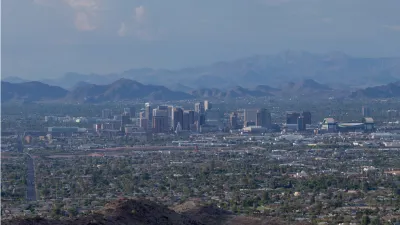Phoenix, once described as 'the world’s least sustainable city' is focusing growth on its downtown and investing in light rail and bike share to attract high tech companies and workers.

"[T]he Phoenix that has been disparaged by so many is undergoing a change," writes Fernanda Santos, Phoenix bureau chief for The New York Times. Santos includes not one but four references to the city's negative reputation.
The change "began when the housing bubble burst and affordable home after affordable home went into foreclosure," adds Santos. "The collapse started in new-housing areas on the fringes [in 2007] and then swept inward, hitting more established areas as the unemployment rate climbed," according to The Arizona Republic
"City officials, intent on revitalizing the place, searched for a new formula, one that focused not on the outer edges of the desert, where there remains plenty of room to expand outward, but on the long-neglected downtown," continues Santos.
These days, there is hardly an empty lot left in the city’s core, and there are as many apartments under construction, or about to be built, as all of those that were built from 1996 to 2008. But, are there enough people to fill them? That is a multibillion-dollar gamble, and Phoenix has gone all in.
Mayor Greg Stanton added transportation to the effort with a successful sales tax measure last summer for extending light rail.
A bike-sharing program survived its first summer, a time of the year when riding a bike, or doing any other outdoor activity for that matter, is borderline heroic.
The thrust of the article is on Stanton attempting to attract Silicon Valley businesses, workers, and millennials to the city, by building a vibrant, dense downtown.
“I don’t want people to move here because we have great golf courses and cheap homes,” Mr. Stanton said in an interview. “What I want is young college graduates from the East Coast moving here, and our college graduates staying here because they see their future here and we have a great urban community.”
FULL STORY: Phoenix Focuses on Rebuilding Downtown, Wooing Silicon Valley

Analysis: Cybertruck Fatality Rate Far Exceeds That of Ford Pinto
The Tesla Cybertruck was recalled seven times last year.

National Parks Layoffs Will Cause Communities to Lose Billions
Thousands of essential park workers were laid off this week, just before the busy spring break season.

Retro-silient?: America’s First “Eco-burb,” The Woodlands Turns 50
A master-planned community north of Houston offers lessons on green infrastructure and resilient design, but falls short of its founder’s lofty affordability and walkability goals.

Test News Post 1
This is a summary

Analysis: Cybertruck Fatality Rate Far Exceeds That of Ford Pinto
The Tesla Cybertruck was recalled seven times last year.

Test News Headline 46
Test for the image on the front page.
Urban Design for Planners 1: Software Tools
This six-course series explores essential urban design concepts using open source software and equips planners with the tools they need to participate fully in the urban design process.
Planning for Universal Design
Learn the tools for implementing Universal Design in planning regulations.
EMC Planning Group, Inc.
Planetizen
Planetizen
Mpact (formerly Rail~Volution)
Great Falls Development Authority, Inc.
HUDs Office of Policy Development and Research
NYU Wagner Graduate School of Public Service

























